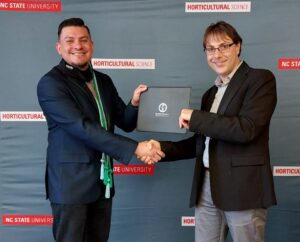 Congratulations to Bryan Munoz, PhD. Bryan defended his dissertation on September 20 and graduated on December 14, 2021 from the Department of Horticultural Science. During his time at PHHI, Bryan was a graduate mentor in the Plant Pathways Elucidation Program, where he guided undergraduate interns through a summer research project. Bryan’s research focus was on Black Sigatoka disease resistance in banana. Read a summary of his work below.
Congratulations to Bryan Munoz, PhD. Bryan defended his dissertation on September 20 and graduated on December 14, 2021 from the Department of Horticultural Science. During his time at PHHI, Bryan was a graduate mentor in the Plant Pathways Elucidation Program, where he guided undergraduate interns through a summer research project. Bryan’s research focus was on Black Sigatoka disease resistance in banana. Read a summary of his work below.
Summary of Dissertation
Characterization of edible banana germplasm for nutritional improvement and resistance to Black Sigatoka disease
Bananas (Musa spp.) are the second most consumed fruit globally and is a staple crop in tropical and subtropical regions. Given its high consumption, efforts to improve provitamin A carotenoids, bioactives content and disease resistance through breeding strategies are ongoing. Achieving these goals will make banana production more sustainable and may contribute to improving consumer health through enhanced nutrition.
To contribute toward these efforts, a collection of 27 edible banana accessions were evaluated for carotenoid content, bioaccessibility, starch and sugar content, total phenolic content, and resistance to Black Sigatoka (causal fungal agent, Mycosphaerella fijiensis). Results of these analyses were used to: 1) understand the relationships between carotenoid content and bioaccessibility and how these characteristics are affected by ripening treatments (natural vs. artificial) and the ripening stages; 2) identify banana accessions with high phenolic content in the pulp and evaluate the effect that post-harvest ripening has on phenolic content and sugar accumulation; 3) understand how stable Black Sigatoka resistance is within 18 edible banana accessions; and 4) to characterize the defense response triggered by the P. fijensis effector protein PfAVR4 on the expression of five genes involved in the plant-pathogen interaction pathway.
Bioaccessibility, carotenoid, sugar, and phenolic content
Carotenoid, sugar, total phenolic content, and Black Sigatoka resistance were found to be genotype-dependent. Compared with Cavendish, the most commonly grown and consumed banana cultivar, several accessions had higher carotenoid, sugar, and phenolic content. In most accessions, carotenoid and sugar content increased from unripe to ripe fruit, while total phenolic content stayed stable during ripening. Banana accessions ripened with exogenous ethylene had a significantly higher carotenoid and sugar content and carotenoid bioaccessibility, however, a lower total phenolic content was observed. Relative bioaccessibility was not significantly correlated with carotenoid content, but was moderately correlated with resistant starch. Six accessions had high phenolic content in the pulp, almost as high as in the peel and was up to three-fold higher than what has been previously reported in bananas.
Black Sigatoka resistance
Response to Black Sigatoka infection was evaluated under three conditions: 1) field; 2) in vitro leaf disc assay; and 3) inoculation of whole plants using controlled conditions. These experiments confirmed that Calcutta IV, FHIA 25, and Ducasse are highly resistant, while Cavendish was found to be highly susceptible. An uncharacterized accession collected in Costa Rica, Bri Bri, was identified as a new source of moderate resistance to Black Sigatoka, which also had high sugar and carotenoid content and high bioaccessibility. Resistant plants inoculated with the PfAVR4 effector protein expressed a hypersensitive response (HR), demonstrating a possible gene-for-gene resistance mechanism, whereas the susceptible plants did not. The expression level of three resistance genes, named PR4, PR10, and R4, were consistently upregulated at 6 to 36 hours after inoculation with the PfAVR4 effector protein or conidia. Interestingly, in resistant plants inoculated with the PfAVR4 effector protein, a very high expression of PR4 was detected 6 HAI, which coincided with the initial appearance of HR symptoms which included small necrotic lesions and upregulation of the peroxidase enzyme (POX). These observations suggest that PR4, which was previously identified to be upregulated in resistant plants inoculated with P. fijensis, is a strong candidate gene that recognizes the PfAVR4 effector, triggering the HR response and ultimately conferring resistance to Black Sigatoka.
Overall, the results of this study are informative to banana breeding and production programs about genetic materials and strategies to improve nutrient delivery, bioactive content and Black Sigatoka resistance. In addition, it establishes the foundation to further understand the genetic and molecular mechanisms controlling these traits, which are critical steps to developing enhanced nutrition and a sustainable crop improvement program.

